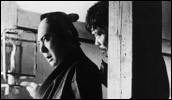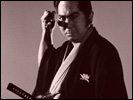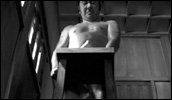Hanzo the Razor: Sword of Justice
- Year
- 1972
- Original title
- Goyokiba
- Japanese title
- 御用牙
- Director
- Cast
- Running time
- 108 minutes
- Published
- 14 December 2006



by Tom Mes
From James Bond to blaxploitation, the virile man has long been a staple of popular cinema. Where 007 tried his damndest to disprove the age-old "No sex please, we're British", John Shaft (what's in a name) and company went a step further to become, as the poster said, "Hotter than Bond, cooler than Bullit."
Based on a manga by Lone Wolf and Cub creator Kazuo Koike, Hanzo the Razor is Japan's attempt to supply a superlative to the American comparative and the British regular. Fearless Edo-period police inspector Hanzo Itami (Katsu), nicknamed The Razor, has developed his own unique way of extracting information for his enquiries, using his rock hard and monstrous member to coax a succession of courtesans and ladies-in-waiting into spilling the beans. His first adventure sees him investigating his superior officer's mistress, whom he suspects of having ties with a reputed criminal on the loose.
The Razor films have often been labelled sleazy and offensive, mostly by those who hadn't actually seen them and likely relied on synopses to form their opinions. The premise certainly sounds nasty enough, but as the saying goes, if it were all about the story, there wouldn't be any need to make the film. The DVD re-issues by Home Vision in the US and Eureka in the UK allow us to see for ourselves that there is thankfully a little bit more to Hanzo's shenanigans than salacious shock.
In exaggerating the aspect of male virility, Hanzo the Razor above all mocks it. The shadows and outlines of Hanzo's imposing member suggest an organ that would drive an Andalusian bull into a jealous rage. When the protagonist starts hammering his rod with a mallet and poking it into bails of rice to strengthen it, we know that what we're meant to do here is not recoil in disgust but laugh in amusement. Yes, this is a parody. A dubious one perhaps, but a parody nonetheless. Hanzo's interrogation tactics have moved beyond torture, he has tried out all known methods of forced interrogations on himself and come to the conclusion that pleasure is a much more effective way of extracting information than pain. Like the British secret agents and Harlem private dicks that came before him, he's as much a lover as he is a fighter.
In keeping with the tone of many of Koike's manga from the period, not in the least Lone Wolf and Cub, Hanzo the Razor is furthermore marked by a conspicuous anti-feudalistic attitude. In addition to flaunting the rules of police brutality, Hanzo treats the shogunate's strict hierarchy with complete disdain. Daimyo lords, government figureheads, and, most of all, his weasely superior Magobei "The Snake" (Nishimura, who nearly steals the show in each of the three films in the series): all are subject to Hanzo's insults and strong-arm tactics if they dare stand in his way. As incorrigibly impudent as he is priapic, Hanzo's insubordination is matched only by his unwavering devotion to his job: protecting the citizens of Edo from crime. This makes the character ideally suited to director Kenji Misumi, whose filmography is characterised by an examination into the merits, of rather the lack thereof, of bushido and the samurai spirit.
Shintaro Katsu returned as Hanzo the following year in The Snare (Goyokiba: Kamisori Hanzo Jigokuzeme), written and directed by former Daiei provocateur Yasuzo Masumura, of Blind Beast fame. In what is probably the most entertaining entry in the short-lived series, the fearless constable investigates the death of a merchant's daughter. "Women are a riddle. The best place to find the truth is in here," he proclaims before inserting his hand up the victim's privates and discovering that she died from a failed abortion. This clue leads him to underground abortion ceremonies, sex slave rings, and monetary counterfeiting operations. All of which are conveniently overseen by women, making Hanzo busier with his interrogations than ever.
Masumura also scripted the third and final instalment, subtitled Who's Got the Gold (Goyokiba: Oni no Hanzo Yawahada Koban, 1974), helmed by his former assistant director Yoshio Inoue. Despite a plot about drug-induced orgies, it's the most outright parodic of the three, with even the kaidan genre receiving a pie in the face. It is never less than entertaining, but the central gimmick grows stale and the scenes of Hanzo working his jimmy and interrogating his suspects become repetitive. Impressive as it may have looked at first, there finally just wasn't enough mileage in Hanzo's Razor.